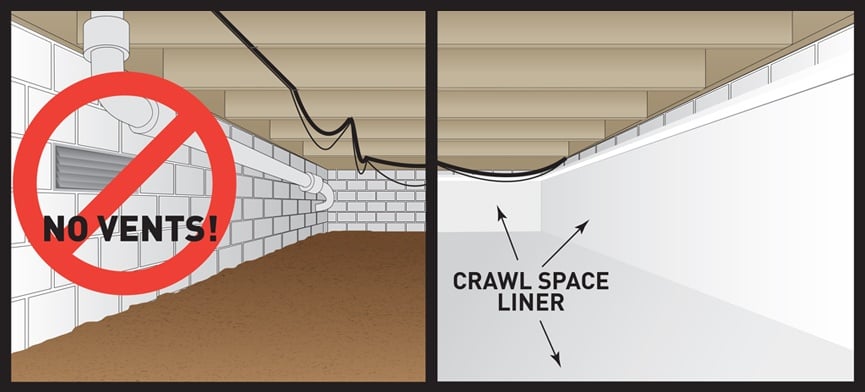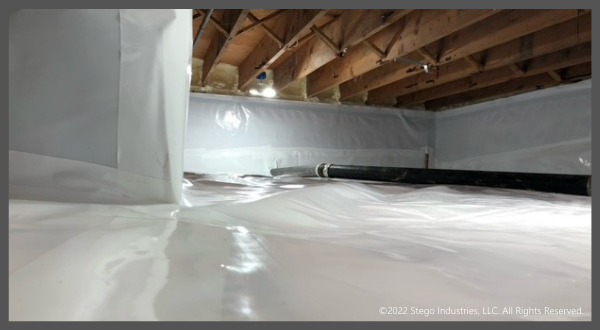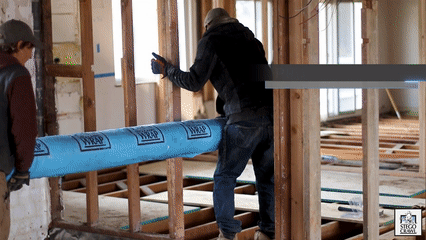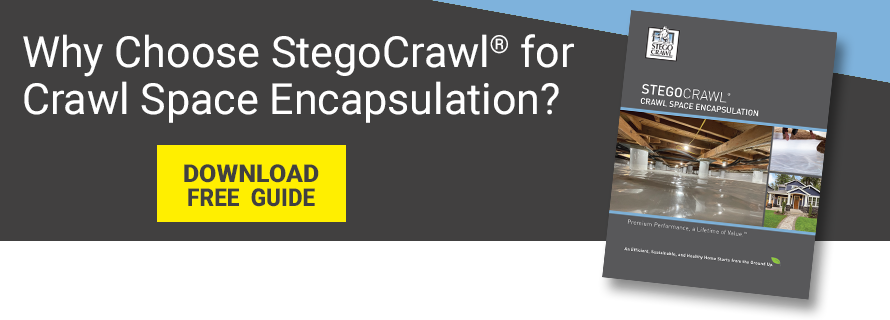Are Crawl Space Vents Necessary? Surprising Facts You Need to Know
Why Eliminating, Sealing, or Closing Crawl Space Vents in Conjunction With a Crawl Space Vapor Barrier Can Help Contribute to a More Durable, Efficient, and Healthy Home.

For many years, it was believed that crawl spaces needed to be vented to the outside. The theory has been that openings (or “vents”) installed at the foundation wall between the exterior and crawl space would allow air exchange, enabling fresh air to come in while stagnant air moved out. The thinking is this air movement into, through, and out of the crawl space keeps it dry and helps reduce mold, soil gases (like radon), and other pollutants.
There is certainly some logic to this traditional thinking – not too dissimilar to how I used to roll down the windows of my car when it got too stuffy or hot inside, I needed some “fresh air”. In fact, even building codes (e.g. International Residential Code) include verbiage calling for vents in crawl space foundations to allow for this natural ventilation.
However, it turns out that, in many cases, open vents in crawl spaces actually cause more harm than good 🤯. And the problems can arise regardless of seasons or climate, which are commonly cited as rationale for crawl space vents. As understanding of building science has continued to improve, as well as useful crawl space studies, there is clear evidence to support the benefits of closing, sealing, or eliminating crawl space vents. The simple explanation is that outside air is often not ideal to ventilate with and it is difficult (if not impossible) to control. For the bigger picture, keep reading.
It should be noted, the building codes have evolved too (2x 🤯). Although under-floor ventilation via vents in foundation walls is an optional path, the residential code makes it clear that vents can be eliminated, as long as the crawl space is also sealed and conditioned. In other words, rather than relying on outside, uncontrolled air to provide ventilation, we simply treat the crawl space more like the rest of the home – isolated from the outside, clean, predictable, and comfortable with the help of mechanically-controlled air movement.
Note: Always check your local building codes for specific crawl space requirements.
The Building Science Behind Covering or Removing Crawl Space Vents
If your existing home has crawl space vents, consider covering them as part of an integrated approach to improving home performance..png?width=600&name=closed-vents%20(1).png) If you’re building a new home with a crawl space, consider following the second option in the building code and leave the vents out of the picture. Warm air is never totally without moisture, no matter which climate of the US you live in. Of course, in some areas (or even certain times of the year) the concern of warm, moist air movement in the crawl space is more pronounced…think summer in the Southeast. Nature is constantly trying to reach equilibrium, thereby introducing the two culprits of vapor drive – temperature and humidity differences. Here’s how it works:
If you’re building a new home with a crawl space, consider following the second option in the building code and leave the vents out of the picture. Warm air is never totally without moisture, no matter which climate of the US you live in. Of course, in some areas (or even certain times of the year) the concern of warm, moist air movement in the crawl space is more pronounced…think summer in the Southeast. Nature is constantly trying to reach equilibrium, thereby introducing the two culprits of vapor drive – temperature and humidity differences. Here’s how it works:
1. Temperature Differentials
With a national average soil temperature of 55 degrees Fahrenheit, your crawl space would naturally stay relatively cool. In the warm summer months, as temperatures climb outside your home, that warm air is going to try to reach a balance with the cooler temperature of your crawl space. As this happens, the warm air outside is naturally driven into your crawl space and will move freely through vents.
2. Humidity Differentials
As the warm air outside is exchanging with the cooler air of your crawl space, so is the humidity. Lower humidity likely to be found in your crawl space is exchanging with higher humidity outside (depending on the geographic area, time of year, and even time of day). The point is, you want to eliminate the opportunity for moisture-laden air to be driven into your crawl space.
Humid air in the crawl space is a top concern given the potential for it to condense on colder surfaces, such as wood framing and HVAC equipment, which can cause a range of moisture-induced problems like mold growth, wood rot, and corrosion to metal. Those occurrences induce poor indoor air quality, structural damage, and need for mechanical repairs respectively. Natural water vapor diffusion and stack effect can also lead to potential flooring failures and energy inefficiency as moist air from the crawl space migrates through the home’s envelope while endeavoring to reach equilibrium.
Although drier, more moderate climates may not necessarily deal with the degree of humidity-related issues from outside air, vented crawl spaces present other concerns that span climate zones:
- Outdoor pollutants exposure
- Odors
- Hot or cold temperatures
- Water infiltration
- Insect and pest infestation
These issues can be amplified with a vented crawl space that essentially allows the outside to come in.
The Benefits You'll Experience from Being Vent-Free
After you’ve had the opportunity to cover or remove your crawl space vents, it will be important to take the ground in your crawl space out of play. The ground is another source of moisture that will constantly be trying to reach equilibrium with the space above it. You can do so by encapsulating with a quality crawl space vapor barrier liner. Here are the benefits you should start to notice almost immediately:
- Lower Humidity in the Crawl Space - This should result in better indoor air quality – less mildew, mold, and associated odors.
- Leveled Temperatures - Without air temperatures competing, you should see a leveling of the crawl space temperatures in your crawl space and that should result in better energy efficiency from your HVAC system.
- Cleaner - Taking the ground out of play helps control dust and airborne spread of other soil particularities.
- Radon Control - A quality vapor barrier will serve as an important component of a radon mitigation system.

What About Radon Gas if There is No Air Flow?
Many people have pointed to open foundation vents in crawl spaces as a means to help reduce radon in homes. Again, the theory is, incoming fresh air (with reduced radon), would replace the internal air (with stagnated concentrations of radon) expelling the radon gas molecules with it before radon reaches the interior living space. Sure, in theory, this could help, but is it enough to reduce your internal radon concentration to safe exposure levels? The radon mitigation industry doesn’t rely on open foundation vents in hopes that enough air is exchanged to reduce radon levels safely. Rather, radon mitigation standards from AARST (American Association of Radon Scientists and Technologists) prescribe a controlled and predictable approach for new and existing crawl spaces. Let me elaborate on what that means: they recommend a closed crawl space with a properly installed vapor barrier (or soil-gas retarder as it is often called in the radon industry) in conjunction with a sub-membrane depressurization system with a vent pipe and mechanically controlled fan to expel radon gas away from the home. It is with that prescription, that you get consistent and regulated air exchanges, enough to purge the concentration of radon from your home. The bottom line, with a proper mitigation system like this is: unvented crawl spaces can help prevent radon.

Don't Stop There - There's More to it Than Just Sealing the Vents
Sealing, closing, or eliminating open vents is not the end-all solution to an improved crawl space and overall home performance. Taking the ground out of play with a quality vapor barrier is also an important component, but in many cases, you will also need to consider and implement strategies for a fully integrated and effective approach. Particularly for existing homes, this may include dealing with liquid water, structural repair, cleanup, mold removal, etc. For new or existing homes, the approach to an unvented crawl space needs to also include proper insulation, air sealing, and conditioning.
Conditioning, which is maintaining an appropriate humidity and temperature via mechanical equipment, helps achieve the same benefits attributed to open crawl space vents; that is, air exchange to remove humidity and other undesirable conditions.
Thus, the solution that works in all climates and throughout the entire year is treating the crawl space more like the rest of the home…seal it off from the outside, insulate at the perimeter to reduce heat loss, and use mechanical equipment to provide predictable and controlled air movement to help keep the crawl space clean, dry, comfortable, and healthy.

Written by Tom Marks
Tom Marks is the Business Development Project Manager with Stego Industries, LLC. He has been with Stego since 2007, serving many years as the Rocky Mountains Regional Manager. Now, his focus is geared toward vapor barrier solutions for new and existing homes as the Product Manager of the StegoHome and StegoCrawl brands. In addition, Tom serves as Sustainability Manager, overseeing Stego’s leadership in holistic product and corporate sustainability. Tom enjoys working with a wide range of project team members and customers to incorporate effective sub-slab vapor protection and create healthy, sustainable homes and buildings.
- Stego (26)
- StegoCrawl (24)
- Stego-Awareness (17)
- StegoHome (15)
- Case Studies (14)
- StegoCrawl-Consideration (12)
- StegoCrawl-Awareness (11)
- Customer Stories (9)
- Stego-Consideration (9)
- Pango (8)
- StegoHome-Consideration (8)
- Beast (7)
- How to Install (7)
- StegoHome-Awareness (7)
- Drago (5)
- Pango-Awareness (5)
- Beast-Awareness (4)
- Beast-Consideration (3)
- Drago-Awareness (3)
- Pango-Consideration (3)
- Stego IQ (3)
- Drago-Consideration (2)
- StegoCrawl-Decision (2)
Popular Posts
Stay Connected.
Enter your email below.








Post Comments